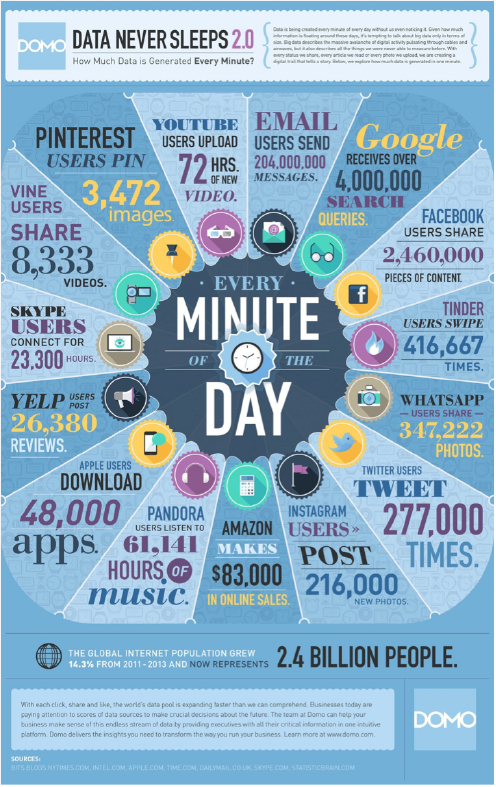Why big data is making smarter marketers think small…

Effectively harnessing the enormous quantities of data your business accumulates day-to-day can help you get ‘up close and personal’ with your customer base – delivering razor-honed messages and offers directly to the most narrowly defined ‘micro’ market segments.
It’s over three decades since former Hewlett Packard CEO Lew Platt remarked,
“If only HP knew what it knows, it would make three times more profit tomorrow.”
Disturbingly few marketers have, as yet, taken that sentiment to heart – a fact that’s made all the more remarkable by the sheer volume of data that, nowadays, those marketers have at their disposal.
And therein of course lies one of the problems: running to terabytes and even petabytes, that data simply cannot be tamed using conventional tools (existing databases, spreadsheets and the like).
But tamed it must be, if your business is to compete in an increasingly congested ‘me-too’ marketplace. So what’s to be done?
Back when Lew was waxing self-effacingly insightful, ‘big data’ could be measured largely in mail: reply cards, ad coupons and return faxes, allied to media schedules and sales reports.
Today we have access to a whole raft of data – some of it structured, much of it not – originating in things like user-generated content (blogs, Facebook posts, comments on news sites, video uploads), emails, smartphone usage, geolocation stats, point-of-purchase data, online browser behaviour… and much – much – more besides.
Consider this….
90% of the data in the world today has been created in the last two years alone (source: IBM, 2013). By 2025, approximately 463 exabytes would be created every 24 hours worldwide.
Trouble is, that data – however ‘big’ – is not information. In order to become information – and to deliver real business insight – it has to be stored, analysed, interrogated, manipulated… and applied – creating the need for prodigious amounts of storage space and computing power.
And that’s not all.
As luminaries such as Gartner observe, since more than 80% of the data we collect is unstructured – lacking a standardised length and format (e.g.: numbers, dates, defined groups of words) – it cannot be interpreted using most firms’ existing technologies.
Which is a shame – because it can support a level of decision-making that is quite unprecedented: enabling you to make better-informed business decisions faster than ever before.
It’s time to get personal
Big data can deliver unparalleled insight into who your customers are (demographics, psychographics), their locations, occupations, interests, how they prefer to be contacted, and even when – equipping you to create unerringly accurate ‘personas’ for each of your target audiences.
For those who are unfamiliar with the term, a ‘persona’ in marketing-speak is an archetypal representation of who your buyers are, what they are trying to accomplish, what goals drive their behaviour, how they think, how they buy, why they make buying decisions, where they buy and when.
Big data provides you with the raw material you need to pare down each audience to the fabled ‘segment of one’… Well, theoretically.
In reality, most firms are not there yet. For the majority, display ad targeting – by way of example – is still limited to relatively broad criteria (such as age, sex, location and so on).
And if they’re really clever – or they have a switched-on digital agency behind them – those firms may go on to ‘chase’ their prospects (those who have visited their site, but failed to purchase) around the web, using customised banner ads.
Clearly this approach works – as you can see for yourself, simply by reviewing the ads that pop-up after you’ve spent an hour or two online. Surprisingly relevant, aren’t they?
Well, that’s the power of big data. But it could be so much better…
Case in point: Morton’s The Steakhouse
When a regular customer, somewhat tongue in cheek, Tweeted how he’d like a Chicago steakhouse chain to deliver dinner to Newark airport (where he would be arriving late, following a long day at work), the firm called his bluff.
Seeing the Tweet, a staff member found that the Tweeter was actually a frequent customer. So, he pulled the data on the customer’s typical order, identified which flight he was on, and sent a tuxedo-clad waiter to serve him his dinner on his arrival.
The exercise was, of course, a publicity stunt. But it went viral, proving – if proof were needed – the raw power that can be derived from harnessing big data.
As the case study clearly demonstrates, our customers are helping us to market to them with almost every online (and indeed offline) step they take.
Just look at the ways they spend their time– then consider all the clues, as to their buying motivations, that they’re leaving us along the way.

As the infographic (thanks, Domo) shows, web-users leave mountains of information in their wake – about themselves and their buying habits – providing you with all the raw material you need to communicate with your prospects and customers on their terms.
The magic word: granularity
Acknowledging that markets don’t comprise thousands of customers (rather, they’re made up of thousands of individuals) marketers speak long and often of granularity.
Granularity equips you to answer, in microscopic detail, your customers’ perennial question: what’s in it for me? – ensuring your value proposition, offers, ads, emails and other communications are absolutely relevant to them.
And relevance, as we all know = engagement. And engagement = sales!
Just as in paid-search – where you strive to utilise ‘long tail’ (tightly-confined, highly detailed) search terms, to narrow your audience (minimising costly clickthrough) and drive response only from your ‘hottest’ prospects (those who are likely to buy) – granularity enables you to slash the number of people that will be exposed to specific messages. And to optimise conversion rates among those that do.
So: a (final) farewell to mass marketing, then? Well, one day.
Unfortunately, for many firms, big data is still just too… well…. troublesome. It’s far easier, surely, to maintain the status quo – where ‘personalised marcomms’ means adding the customer’s name (and maybe a tailored offer or two) to the body copy of your email.
And let’s face it: that approach still works, doesn’t it?
Moreover, they reason, big data demands a level of technological sophistication that is beyond their reach. Which makes it the IT department’s problem, right?
Actually, no. Big data is not a job for the IT department in isolation. Rather, marketers must get much more closely involved to help their tech-minded brethren to understand their core challenges. And in so doing to unlock the critical business insight that’s actually well within their grasp.
The key to unlocking your data: Analytics
The application of ever more sophisticated analytics tools – from the likes of Amazon Web Services, Cloudera, 1010data, Hortonworks and IBM (hey: no one ever got sacked for hiring them) – will enable you to spot and respond to changing trends and behavioural patterns; to stay on top of customer sentiment and brand associations; and to preempt new threats and opportunities.
It can help to explain what influences customer loyalty too: what keeps those customers coming back… and what really turns them off.
Above all, big data provides the insight you need to think far more strategically:
to determine your optimal marketing spend – selecting the right channels, defining and refining your messages, and monitoring your success (or otherwise) in real time, so as to deliver maxim bang for your marketing buck.
The number of companies that have fully implemented big data has more than doubled in the past year, while more than eight in 10 have increased investment. According to a new survey, accuracy, insight and process optimisation seen as the biggest business benefits of big data. According to a survey by Whishworks (2019), 81% of respondents said that the investment in big data projects is increasing in their companies.
VERSIO VITA LIMITED (11821196). Registered address: e-space North, 181 Wisbech Road, Littleport, Ely, England, CB6 1RA
